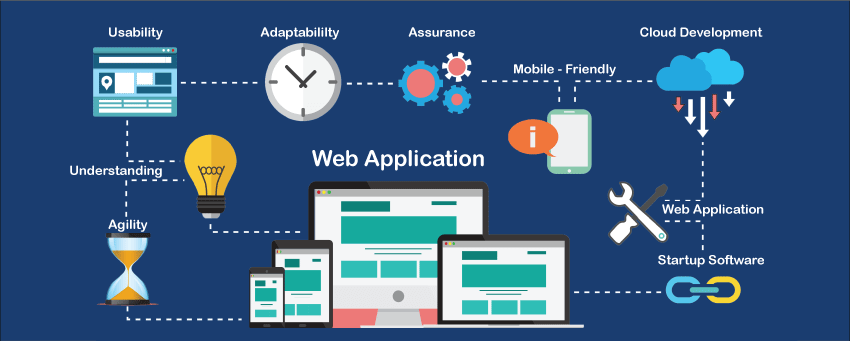Strategies for Building Scalable and Efficient Web Applications
- 1 Understanding Scalability and Efficiency
- 1.1 Scalability
- 1.2 Efficiency
- 2 Importance of Balancing Scalability and Efficiency
- 3 Common Challenges in Web Application Scalability and Efficiency
- 3.1 A. Identifying Bottlenecks and Performance Issues
- 3.2 B. Dealing with Increased User Load and Data Volume
- 3.3 C. Handling Concurrent Requests and Maintaining Responsiveness
- 3.4 D. Managing Resource Utilization and Cost-Effectiveness
- 4 Strategies for Building Scalable and Efficient Web Applications
- 4.1 Microservices Architecture:
- 4.2 Serverless Architecture:
- 4.3 Event-Driven Architecture:
- 4.4 Horizontal Scaling:
- 4.5 Database Optimization:
- 4.6 Content Delivery Network (CDN) Integration:
- 4.7 Asynchronous Processing:
- 4.8 Continuous Integration and Deployment (CI/CD):
- 4.9 Monitoring and Performance Testing:
- 5 Conclusion
The success of web applications hinges on two critical factors: scalability and efficiency. Scalability refers to a web application’s ability to handle growing amounts of traffic and data without compromising performance, while efficiency pertains to achieving optimal performance and resource utilization. Scalability and efficiency are paramount for ensuring seamless user experiences, maintaining competitive advantage, and managing operational costs effectively. Implementing these strategies is essential for any App Development Company in Dallas aiming to deliver high-quality web applications that meet the demands of modern users and businesses.
Understanding Scalability and Efficiency

Scalability
Scalability in the context of web applications refers to the ability of a system to handle an increasing amount of work or demand by adding resources to the system. It involves designing and architecting web applications in such a way that they can adapt and grow without compromising performance or reliability. Scalability can be achieved through various means, including horizontal scaling (adding more machines) or vertical scaling (increasing the resources of existing machines). In essence, scalability ensures that a web application can handle a growing user base, increasing data volume, and higher traffic levels without experiencing degradation in performance or downtime.
Efficiency
Efficiency in the context of web applications pertains to the optimal utilization of resources to achieve desired performance outcomes. It involves minimizing resource consumption, such as CPU cycles, memory usage, bandwidth, and storage, while maximizing the throughput and responsiveness of the application. Efficient web applications are characterized by their ability to deliver high performance with minimal overhead, ensuring that users can access and interact with the application smoothly and responsively. Efficiency can be achieved through various means, including optimizing code, minimizing network latency, implementing caching mechanisms, and leveraging efficient data storage and retrieval techniques.
Importance of Balancing Scalability and Efficiency
Balancing scalability and efficiency is crucial for web applications’ long-term success and sustainability. While scalability ensures that a web application can accommodate growing demand and scale resources dynamically, efficiency ensures that resources are utilized optimally to minimize costs and maximize performance. Finding the right balance between scalability and efficiency is essential to avoid over-provisioning or underutilization of resources, which can lead to unnecessary expenses or performance bottlenecks.
Common Challenges in Web Application Scalability and Efficiency

A. Identifying Bottlenecks and Performance Issues
One of the primary challenges in achieving scalability and efficiency in web applications is identifying bottlenecks and performance issues. These bottlenecks can manifest in various forms, such as slow database queries, inefficient code execution, network latency, or resource contention. Identifying and mitigating these bottlenecks is essential for ensuring optimal performance and scalability. This often requires thorough application monitoring, profiling, and performance testing to pinpoint areas of concern and implement optimizations effectively.
B. Dealing with Increased User Load and Data Volume
As web applications grow in popularity and usage, they often face challenges related to increased user load and data volume. Handling a large number of concurrent users and processing vast amounts of data in real-time can strain the resources of the application and impact performance. Scalable architectures and efficient data management strategies are crucial for mitigating these challenges. Techniques such as horizontal scaling, data sharding, caching, and asynchronous processing can help distribute the workload and manage data effectively, ensuring the application remains responsive and scalable even under high load conditions.
C. Handling Concurrent Requests and Maintaining Responsiveness
Web applications frequently encounter situations where multiple users simultaneously access and interact with the system. Handling concurrent requests efficiently while maintaining responsiveness is essential for a seamless user experience. Handling concurrent requests effectively requires multithreading, connection pooling, and asynchronous processing. Optimizing resource utilization and minimizing contention for shared resources can help ensure the application remains responsive and performs well under load.
D. Managing Resource Utilization and Cost-Effectiveness
Efficiently managing resources and ensuring cost-effectiveness is another common challenge in web application scalability and efficiency. Provisioning and scaling resources to meet demand while minimizing costs can be complex, especially in dynamic environments where workload patterns fluctuate. Techniques such as auto-scaling, resource optimization, and cost monitoring are essential for balancing performance requirements with cost constraints. Additionally, leveraging cloud services and serverless architectures can provide scalability and flexibility while optimizing costs by paying only for the resources used.
Strategies for Building Scalable and Efficient Web Applications
Building scalable and efficient web applications requires a holistic approach encompassing various aspects of architecture, design, development, and deployment. Below are key strategies to consider when aiming to build web applications that can handle growth while maintaining optimal performance and resource utilization:
Microservices Architecture:
- Decompose the application into smaller, loosely coupled services.
- Each service should focus on a specific business function or domain.
- Enables independent deployment, scaling, and maintenance of services.
- Facilitates better fault isolation and resilience.
Serverless Architecture:
- Leverage cloud computing platforms to run code without managing servers.
- The pay-per-execution model eliminates the need for provisioning and scaling servers.
- Enables automatic scaling based on demand.
- Ideal for event-driven and stateless workloads.
Event-Driven Architecture:
- Design the application to respond to events asynchronously.
- Utilize message queues and event streams to decouple components and manage workflows.
- Enables efficient handling of asynchronous tasks and event-driven scaling.
- Improves responsiveness and scalability by processing events in parallel.
Horizontal Scaling:
- Scale out by adding more instances or nodes to distribute the workload.
- Utilize load balancers to distribute incoming traffic across instances evenly.
- Enables handling of increasing user load and data volume.
- Ensures high availability and fault tolerance.
Database Optimization:
- Choose databases that support horizontal scaling and partitioning.
- Implement data sharding and replication to distribute data across multiple nodes.
- Utilize caching mechanisms to reduce database load and improve performance.
- Optimize database queries and indexes for efficient data retrieval.
Content Delivery Network (CDN) Integration:
- Cache static assets and content at edge locations closer to users.
- Reduces latency and improves content delivery speed.
- Offloads traffic from origin servers, improving scalability and efficiency.
- Ensures consistent performance across geographically distributed users.
Asynchronous Processing:
- Offload time-consuming tasks to background processes or worker queues.
- Utilize message brokers or task queues for asynchronous task execution.
- Improves responsiveness by processing tasks asynchronously.
- Enables better resource utilization and scalability by freeing up web server resources.
Continuous Integration and Deployment (CI/CD):
- Automate the build, test, and deployment processes.
- Enable continuous integration to detect and fix issues early in the development cycle.
- Implement continuous deployment to deliver updates to production rapidly and reliably.
- Facilitates rapid iteration and deployment of new features, enhancing scalability and efficiency.
Monitoring and Performance Testing:
- Utilize monitoring tools to track application performance and identify bottlenecks.
- Conduct performance testing to simulate user load and identify scalability limits.
- Implement logging and analytics to gain insights into application behavior and user interactions.
- Proactively optimize and fine-tune application performance based on monitoring data.
Conclusion
The above strategies are vital for any web application development company aiming to build scalable and efficient solutions. Firms can ensure robust performance and seamless scalability by embracing microservices, serverless architectures, and event-driven paradigms alongside horizontal scaling and database optimization. Integration of CDN, asynchronous processing, and CI/CD practices further enhances efficiency. Continuous monitoring and performance testing guarantee optimal operation. Embracing these strategies empowers web application development companies to deliver high-performing, responsive, and cost-effective solutions that meet the evolving demands of modern users and businesses.

















